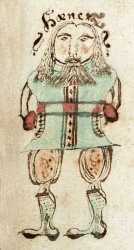Hœnir
One of the Æsir, generally depicted as a companion of Odin. In Völuspá, he and Lóðurr help Odin at the creation of the first human beings, Askr and Embla, infusing them with óðr ("frenzy," "passion"). In Reginsmál, he joins Odin and Loki in their wanderings and is present when Loki kills Ótr, and again in Haustlöng, in which Loki offends Þjazi. In Snorri Sturluson's retelling of these two tales Hœnir has a rather passive role.
After the Æsir-Vanir war, hostages were exchanged between the two groups. The Vanir sent the distinguished Njörðr and Freyr, while the Æsir sent Hœnir and the wise Mímir. According to Ynglinga saga, when they came to Vanaheimr, Hœnir, a stout and handsome man, was immediately made chief, and Mímir provided him with good council on all occasions. However, when Mímir was absent, Hœnir always answered in one way — "Now let others give their advice." The Vanir got a suspicion that the Æsir people had deceived them in the exchange of men so they beheaded Mímir and sent his head back to the Æsir.
In Skáldskaparmál he is periphrased as "Bench-Mate or Companion or Friend of Odin," the "Swift God," the "Long-Footed," and "King of Clay" (aurkonungr). In Haustlöng, Loki is called "Hœnir's friend" and "tester of Hœnir's courage."
Hœnir is one of the few gods who will survive Ragnarök, assuming in the new age a gift of prophesy.
❧
The Hoenir crater on Callisto is named after him.
References
Sources
- Gylfaginning, 23.
- Haustlong, 3, 7, 12.
- Skáldskaparmál, 1, 15, 39.
- Völuspá, 17-18, 61.
- Ynglinga saga, 4.
- Orchard, Andy. (1997). Cassell's Dictionary of Norse Myth & Legend. London: Cassell PLC.
